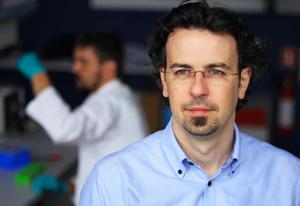Jan 27 2015
Three of the four most fatal cancers are caused by a protein known as Ras; either because it mutates or simply because it ends up in the wrong place at the wrong time. Ras has proven an elusive target for scientist trying to cure the deadly diseases. Now a group from the Department of Chemistry, University of Copenhagen have discovered an unknown way for RAS to find its proper place in the cell. Their discovery may lead to completely novel approaches to curing cancer.
 Professor Dimitrios Stamou heads a team specializing in investigating single cells and cell membranes along with a multidisciplinary team from Bio-Nanotechnology and Nanomedicine Laboratory, Nano-Science Center, Department of Chemistry, University of Copenhagen. Credit: Photo: Jes Andersen/University of Copenhagen.
Professor Dimitrios Stamou heads a team specializing in investigating single cells and cell membranes along with a multidisciplinary team from Bio-Nanotechnology and Nanomedicine Laboratory, Nano-Science Center, Department of Chemistry, University of Copenhagen. Credit: Photo: Jes Andersen/University of Copenhagen.
The findings of Professor Dimitrios Stamou, Post Doc Jannik Bruun Larsen and a multidisciplinary team from Bio-Nanotechnology and Nanomedicine Laboratory, Nano-Science Center, Department of Chemistry are published under the title "Membrane curvature enables N-Ras lipid anchor sorting to liquid-ordered membrane phases" in the highly respected journal Nature Chemical Biology.
Ras-proteins inhabit the interior wall of each and every cell in the human body. Their role is to activate cell division or cell growth, so cancers develop if the protein starts to permanently trigger cells to grow and split: A process known as misregulation.
Ras misregulates if it misses its correct location on the cell wall; its membrane. What Stamou and Larsen discovered is that Ras cannot reach its designated location if the membrane has the wrong shape, explains Professor Dimitrios Stamou.
"If the curvature of the cell is right, Ras goes to the right place. If the membrane is too straight or too bent, it does not. And Ras is very much like any other worker. If it never finds the way to its work place, it is not likely to get any work done", says Stamou.
Ras are thought to be misregulated in upwards of 30 % of all cancers and is specifically linked to highly lethal strains in lungs, colon and pancreas. For three decades researchers have been searching for ways to quench the killer protein. Their lack of success has given Ras a reputation as the "undruggable cancer target" so Stamou is suggesting to head off in an entirely new direction.
"If Ras goes off the rails because of changes in the curvature of the cell, perhaps we should target whatever changes the shape of the cell membrane, says professor Stamou and goes on: "This is a change of perspective similar to when we went from flying with hot air balloons to taking off with fixed wings and propellers".
Looking for a correlation between cell shape and Ras misregulation was unusual bordering on controversial, says Jannik Bruun Larsen. The team was investigating how the proteins attach themselves to the cell wall and Larsen tried to attach Ras to a variety of simulated cell membranes formed into small spheres or vesicles of varying sizes. Ras would attach more readily to smaller balls. These are more curved than large and Larsen started to see a pattern.
"For more than a decade people thought that the constituents of the cell wall was the thing that controlled where Ras was localized, . We have shown, that at least one other aspect, namely membrane curvature, governs where Ras ends up in the cell and is therefore likely to be a factor in cancer development,", says the jubilant Post Doc, Jannik Bruun Larsen.
All of the research so far has taken place on simulated systems in test tubes. The next big challenge is to uncover how these effects play out in living systems, asserts Stamou.
"It will be ten times more difficult to uncover these effects in living systems but it needs to happen. We have started and we really hope others will follow", says Professor Dimitrios Stamou and goes on
"It may prove complicated to develop a drug that changes the shape of cells but I am certain that the discovery of the shape/misregulation-correlation will at least lead to new ways to diagnose cancers".